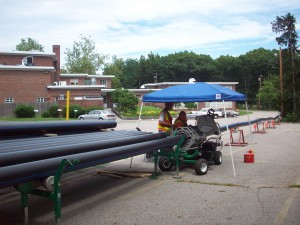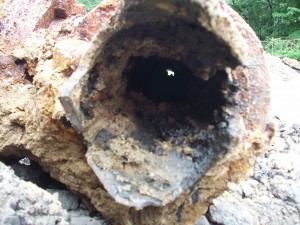October 2011, Vol. 66 No. 10
Features
Pre-Chlorinated Pipe Bursting Offers Effect Water Main Rehab Option

Editor’s Note: The International Pipe Bursting Association (IPBA), a division of NASSCO, is presenting a series of articles in Underground Construction that will provide the reader with a better understanding of the technology. Many myths and misconceptions exist regarding this proven rehabilitation method for replacing existing underground utilities.
Pipe bursting is a proven method for replacing underground pipelines and is the only method of pipeline rehabilitation and replacement other than open cut-excavation that can increase the size of an existing utility without trenching.
This article will discuss replacement of municipal potable water mains utilizing the pre-chlorinated pipe bursting method. This technique has been used for over 30 years in Europe and successfully installed over 100-million feet of new pipe, and has been used in North America for nearly 15 years. This article is written with the assumption that the reader will have a basic level of understanding of the pipe bursting process.
With any construction associated with a municipal water main, the expectation is that service cannot be disrupted for the general public for any extended period of time, which is normally about one work shift. With that said, it is common practice for any construction method to provide either temporary water service or a very limited amount of disruption to an area that is undergoing construction. The temporary water service installation is a cost to the project. Although minimal, disruption to public and private property does commonly occur, often there is some level of damage to existing driveways when they are crossed. Since connections must be made to existing water lines and cross areas that are landscaped and precious to property owners, these may incur damage as well. The cost associated with installation of the temporary water main is typically in the order of a few dollars per linear foot and as public funds are stretched, every dollar that can be invested in installing additional permanent infrastructure is a benefit worth exploring.

First let’s review the most common types of construction associated with water mains and differentiate between rehabilitation and replacement.
With water rehabilitation, the existing pipe is utilized as a host for the new product. The most common and widely accepted methods are sliplining, CIPP, and cement mortar lining (most common), all of which are trenchless methods which can reduce but not eliminate the need for some excavation.
With replacement methods, a new pipe is installed thus fully replacing the existing pipe. These methods are open-cut excavation, HDD, and pipe bursting. Each of these methods requires the existing pipe to be taken off line which disrupts service for differing lengths of time. If that time duration is too long, a temporary above-ground pipe will be installed supplying water to the homes and businesses during construction. Each of these methods has distinct advantages and disadvantages and will also have limitations that should be considered in the feasibility study.
Water bursting
Pre-chlorinated pipe bursting is a method of installing a new pressure pipe that has been fully pressure tested, disinfected and chlorinated per American Water Works Association (AWWA) and local specifications in a manner that only disrupts service for a few hours, thus eliminating the need for temporary services lines. This method of pipe bursting can only be installed by static means due to the need for air lines being installed inside the new pipe through pneumatic means which would compromise the disinfection and require additional cleaning and testing.

The construction starts by pre-fusing a continuous HDPE or PVC pipe above ground and following standard test procedures. A mechanical cap is installed on one end of the pipe and a sealed pipe burst pull head at the other end protecting the pipe from possible contamination during installation. This leaves a fully sealed pipe both during and after the testing. Pressure test, disinfection and chlorination can be performed per standards and the pipe left stored on the jobsite. All static pipe bursting will require a minimum of two pits to be excavated: a pipe insertion pit and a machine receiving pit. Once the pits are excavated, the pipe exposed and proper trench safety measures followed, the water main is ready to be isolated, drained and cut out. This is the timeframe in which service to effected homes, businesses and industry will be without water service. The static pipe burst machine is now set into the receiving pit and high tonnage rods pushed through the existing pipeline. These rods are specially designed to be able to be pushed through heavily tuberculated pipes which eliminates any need for cleaning of the existing pipe. Once the rod reaches the pipe insertion pit, which is typically located 300-500 feet away, tooling is attached that will split the existing pipe, expand the ground to facilitate the outside diameter of the new pipe, and simultaneously pull in the new product pipe. A tracer wire is pulled allowing utility workers the ability to locate the newly installed plastic pipe in the future. Once the new pipe is pulled through from end to end, the pipe bursting machine is removed and mechanical connections used to connect the new pipe to the existing water pipe which is then followed by restoration of service.

The time traditionally required to isolate, install and reconnect a water main from two to 12-inches in diameter is approximately six to 8 hours depending on length and site specific challenges. Pipes larger than 12-inches take approximately 50 percent longer due to the additional work involved with handling pipe and the size of connections.
Service connections
Private service connections must be pre-excavated and manually reconnected following installation of the new mainline. The most common method is by use of an electrofusion saddle or mechanical saddle that will be adapted to the existing service line. It is essential that these services be fully excavated prior to the pipe burst tooling passing by as some types of mechanical saddles can “pull away” from the curb stop instead of splitting which would require additional digging to reconnect to the service. By pre-excavating this connection, it can be disconnected and prepped for reconnection at burst completion.
Fire hydrant connections can be installed by the use of standard DI mechanical tees and valves or by fused HDPE fittings.
Contrary to traditional open-cut excavation, the new pipe will be installed in the existing easement and will reduce excavation by as much as 95 percent. This requires no additional legal work to secure or extend new or existing property easements. Pipes can be replaced along streets that have been planted with either public or private trees including mature trees that are most often very important to the residents of the street. The reduced construction schedule is, in most cases, more than enough of a benefit to the residents to tolerate a period during the day without water service. Provisions should always be made for fire protection and local public services personnel to be included in the pre-construction planning phase in the rare event of a public emergency at a home or business inside the work zone.
With an increasing hydraulic demand on municipal water systems and the most common methods of pipeline rehabilitation only being able to restore existing flows at best, pipe bursting is able to install a new pipe with the same or larger inner diameter, thus giving the system owner the ability to dramatically increase capacity. It is very common with the replacement of municipal water mains to install a pipe of one nominal size larger than the existing pipe and not uncommon to install a pipe two sizes larger than the existing pipe which in some cases increases capacity by approximately 400 percent.
Do your homework, select a quality project team and go pipe bursting! New pipe, more capacity, for pipe bursting the time is now.
Coming in November: Sewer lateral pipe bursting.
FOR MORE INFORMATION:
IPBA (NASSCO), (410) 486-3500, www.nassco.org




Comments